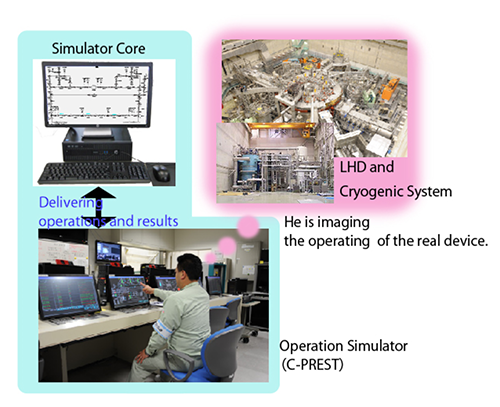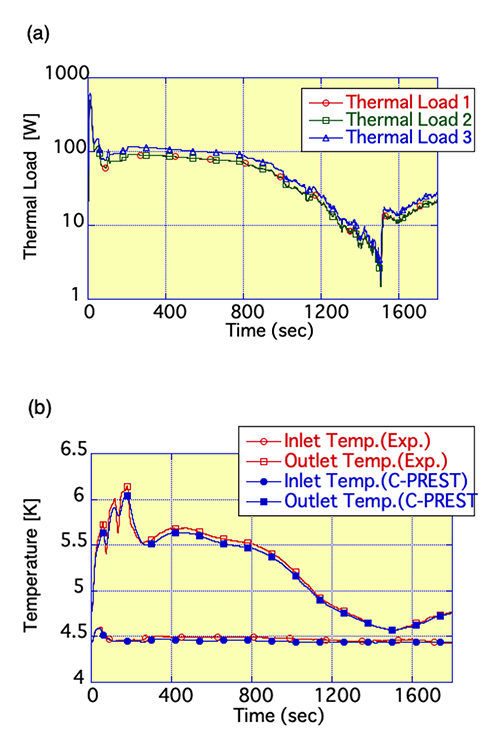HOME > Research Activities > Research Updates >
- Heading for the early establishment of an optimal design and an operating method –
The Large Helical Device (LHD) generates strong magnetic fields to confine plasma by cooling the large superconducting magnet to an extremely low temperature of -270K. In the fusion reactor of the future, the use of a larger superconducting magnet than the one in current LHD is planned. This will be an important problem for designing the cooling device of the magnet and for establishing the operating method. This report introduces developing research on an operating simulator of the cooling device expected to greatly contribute to resolving the problem.
Regarding of the Operating Simulator, everyone imagines simulators of cars, trains and planes. The cooling device of the superconducting magnet does not run as a car, does not have many passengers and runs in seconds as trains and does not fly as planes. You may think, “What is the operating simulator of the superconducting magnet cooling device?”. First, we will explain the necessity.
The devices with the large superconducting magnet such as LHD are often used for special experiments and are made-to-order. The cooling device of the superconducting magnet is also designed and produced according to the magnet to achieve a necessary cooling temperature and performance. In short, both of the large superconducting magnet and the cooling device are said to be the only one in existence. The problem in operating the devices is that we have no experience. How can we achieve efficient cooling? Because the superconducting magnet of the LHD weighs about 800 tons, even if we make changes to the magnet, the magnet often has no response for many minutes after that. In addition, because control information regarding the cooling is more than 1,000 points, it is not easy to judge from the control information and to determine the best operating method. In LHD, we repeated trial and error many times and finally found the satisfactory cooling method for the first time. As a result, we have shortened the necessary period for the cooling to about three weeks , though we took one month for the cooling twenty years ago when we began to operate.
This way, currently, we need many years and much experience to establish the operating method of the large superconducting magnet and its cooling device. A trump card for breaking this present situation is a simulator. This is a system for simulating the operation of the devices by operating the computer in which the superconducting magnet and the cooling device are constructed. If we succeed in developing the simulator, it is possible to try various adjustments and daring challenges before actually operating the devices and to reflect the information in the design the devices. Furthermore, the simulator is useful for training device operators as simulators of trains and planes.
NIFS is developing C-PREST (A Cryogenic Process Real-Time Simulator) which aims towards the realization of this simulator. Now, in C-PREST, we are performing research simulating the cooling method of the large superconducting magnet with high precision. However it is necessary to confirm if the result of the simulator is consistent with the real experimental result to investigate the efficiency of the simulator. Thus, this time, with C-PREST, we attempted to reproduce the experiment carried out at the laboratory of the French Alternative Energies and Atomic Energy Commission(CEA) at Grenoble, France. The experiment carried out at the French laboratory is to simulate the cooling of the superconducting magnet by connecting three test tubes with heaters in series and by running coolant of the supercritical helium of a very low temperature into the tubes. The laboratory carried out the experiment to change a heating load applied to the three tubes and to investigate the cooling performance of the coolant. We applied C-PREST to this experiment, inputted the cooling load for each of the test tubes into the computer and calculated how the temperature of the supercritical helium coming from the supplier changes at the exit. As the result, we could confirm that the simulation result by C-PREST reproduced the real experiment well.
After this, we are more promoting developing research of C-PREST and heading for establishment of the operating simulator of the total device including the cooling system.

Fig. 1: These photographs show development of the operating simulator. Though the core of the simulator is the computer, the operation of this computer enables us to simulate operating the device.

Fig. 2: Comparison between the experiments of the French Alternative Energies and Atomic Energy Commission(CEA) and the simulation results by C-PREST.
(a)Time variation of the heat load to each of the test tubes, which are in line as 1, 2, 3 from the supplier, respectively.
(b)Temperature variation of the coolant (the supercritical helium) at the supplier and the exit. The results of the experiment and C-PREST are well consistent with each other.
